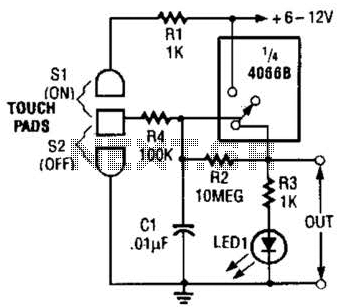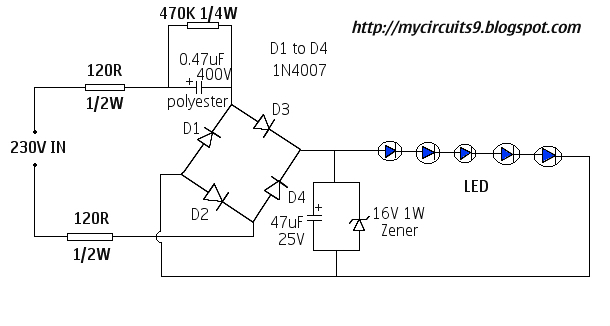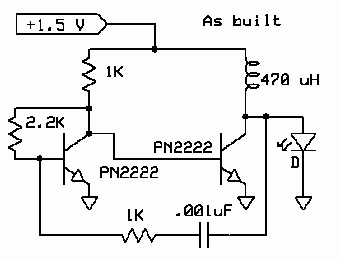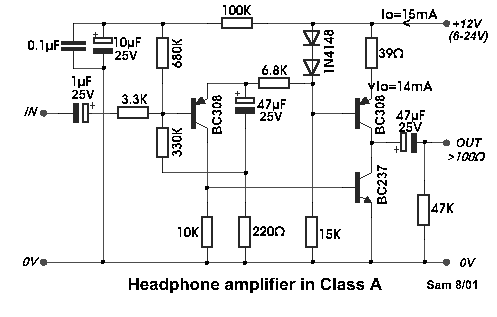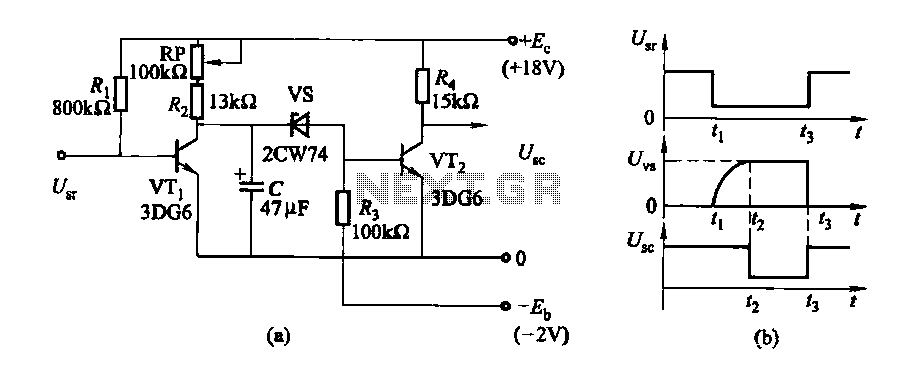
Fluorescent lamp driver circuit composed of FET
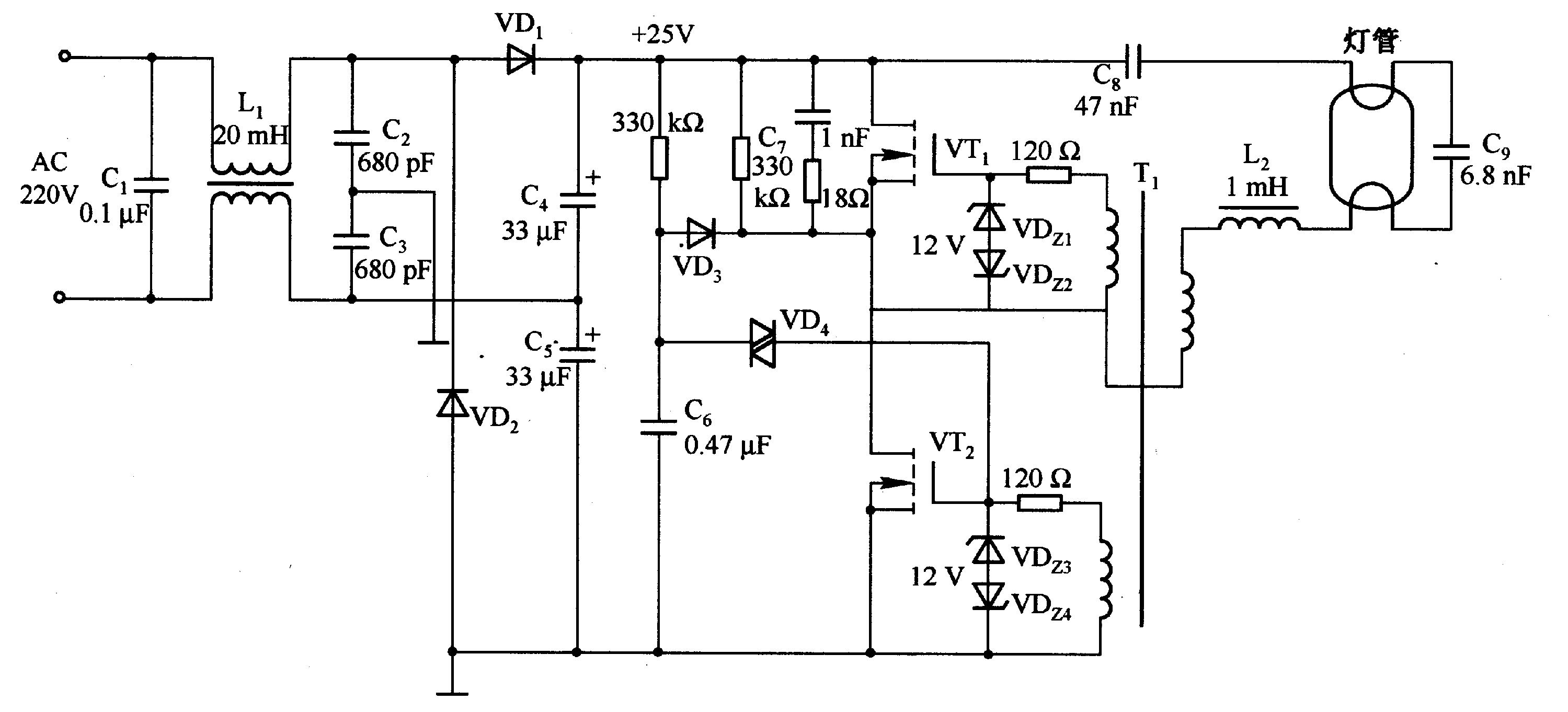
A fluorescent tube is connected in an LC resonant circuit consisting of inductor L2 and capacitor C9. The bidirectional breakdown diode VD4 initiates the starting circuit. When AC power is applied, the gate potential of transistor VT2 increases due to VD4. Once the voltage surpasses the gate threshold voltage, VT2 becomes conductive. Consequently, the resonant current flows through capacitor C8, the fluorescent tube, resonant capacitor C9, choke L2, and the winding of drive transformer T1 powered by a +25 V DC voltage. The oscillation cycle is determined by C9, L2, and T1. Prior to the light turning on, the resonant state is established by components C9, L2, and transistors VT1 and VT2.
The described circuit operates as a starting mechanism for a fluorescent tube using an LC resonant configuration. The inductor (L2) and capacitor (C9) form the core of the resonant circuit, which is essential for generating the high-frequency oscillations required to ignite the fluorescent tube. The bidirectional breakdown diode (VD4) serves a crucial role in initiating the conduction of transistor (VT2) by allowing the gate voltage to rise when AC power is supplied.
When the AC voltage reaches a certain threshold, it triggers VT2, allowing current to flow through the circuit. This current travels through capacitor C8, which helps in stabilizing the voltage across the fluorescent tube, and subsequently through the fluorescent tube itself, which begins to emit light. The resonant behavior of the circuit is pivotal; it allows for efficient energy transfer and ensures that the voltage across the fluorescent tube is sufficient to sustain illumination.
The choke (L2) and the winding of the drive transformer (T1) are also integral to the circuit, as they assist in managing the current and voltage levels, ensuring that the system operates within safe parameters while providing the necessary energy for the fluorescent tube. The oscillation cycle, determined by the interplay of C9, L2, and T1, defines the frequency at which the circuit operates, influencing the performance and efficiency of the fluorescent lighting.
In summary, the interaction between the components—VD4, VT2, C8, C9, L2, and T1—creates a robust circuit that not only starts the fluorescent tube but also ensures its efficient operation through resonant behavior. This design exemplifies the application of LC circuits in lighting technology, highlighting the importance of each component in achieving the desired functionality.Fluorescent tube is connected in the LC resonant circuit composed of L2 and C9. Bidirectional breakdown diode VD4 is starting circuit. When AC power is connected, VT2 gate potential increases by VD4; when the voltage exceeds the gate threshold voltage, VT2 is conducted. Thus, the resonant current folws C8, fluorescent wire, resonant capacitor C9, choke L2, the winding of drive transformer Tl by +25 V DC voltage, and the oscillation cycle is decided by C9, L2, and T1. Before the light iturning on, the resonant state is decided by the C9, L2, and VT1, VT2. 🔗 External reference
The described circuit operates as a starting mechanism for a fluorescent tube using an LC resonant configuration. The inductor (L2) and capacitor (C9) form the core of the resonant circuit, which is essential for generating the high-frequency oscillations required to ignite the fluorescent tube. The bidirectional breakdown diode (VD4) serves a crucial role in initiating the conduction of transistor (VT2) by allowing the gate voltage to rise when AC power is supplied.
When the AC voltage reaches a certain threshold, it triggers VT2, allowing current to flow through the circuit. This current travels through capacitor C8, which helps in stabilizing the voltage across the fluorescent tube, and subsequently through the fluorescent tube itself, which begins to emit light. The resonant behavior of the circuit is pivotal; it allows for efficient energy transfer and ensures that the voltage across the fluorescent tube is sufficient to sustain illumination.
The choke (L2) and the winding of the drive transformer (T1) are also integral to the circuit, as they assist in managing the current and voltage levels, ensuring that the system operates within safe parameters while providing the necessary energy for the fluorescent tube. The oscillation cycle, determined by the interplay of C9, L2, and T1, defines the frequency at which the circuit operates, influencing the performance and efficiency of the fluorescent lighting.
In summary, the interaction between the components—VD4, VT2, C8, C9, L2, and T1—creates a robust circuit that not only starts the fluorescent tube but also ensures its efficient operation through resonant behavior. This design exemplifies the application of LC circuits in lighting technology, highlighting the importance of each component in achieving the desired functionality.Fluorescent tube is connected in the LC resonant circuit composed of L2 and C9. Bidirectional breakdown diode VD4 is starting circuit. When AC power is connected, VT2 gate potential increases by VD4; when the voltage exceeds the gate threshold voltage, VT2 is conducted. Thus, the resonant current folws C8, fluorescent wire, resonant capacitor C9, choke L2, the winding of drive transformer Tl by +25 V DC voltage, and the oscillation cycle is decided by C9, L2, and T1. Before the light iturning on, the resonant state is decided by the C9, L2, and VT1, VT2. 🔗 External reference
